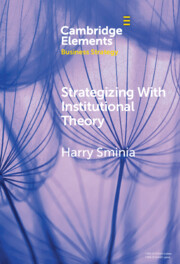Element contents
Strategizing With Institutional Theory
Published online by Cambridge University Press: 21 May 2024
Summary
Information
- Type
- Element
- Information
- Series: Elements in Business StrategyOnline ISBN: 9781009357654Publisher: Cambridge University PressPrint publication: 13 June 2024
References
Accessibility standard: Unknown
Why this information is here
This section outlines the accessibility features of this content - including support for screen readers, full keyboard navigation and high-contrast display options. This may not be relevant for you.Accessibility Information
- 7
- Cited by
